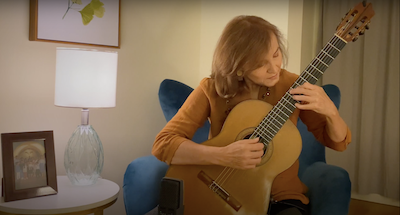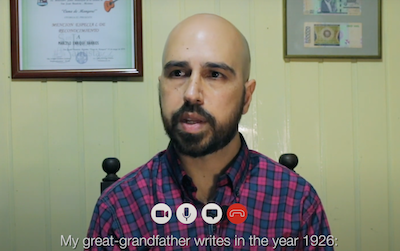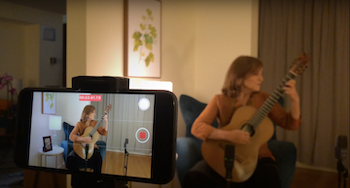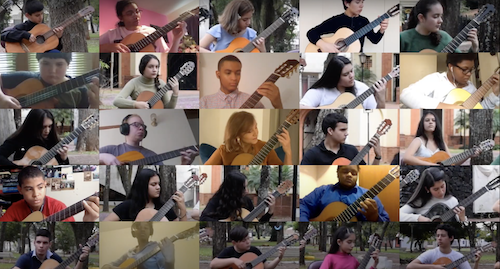by Jarrett Hoffman

Variety has been an emphasis of many recent steamed programs, and this was no exception. Four solo works, two duos, and one guitar-ensemble performance were interwoven with remarks from Rojas, her own conversations with Marcelo Enrique Barrios (the great grandson of Agustín Barrios), and readings from the composer’s letters, all pre-recorded.

Transitions from one segment to the next were slickly produced, if a bit brisk. Was there a fear that audiences watching at home on their devices would be easily distracted? A more relaxed pace would have allowed the words to sink in, especially given the alternating English and Spanish audio and subtitles (a perfect match, by the way, for this virtual format). Perhaps that also would have made it easier for listeners to connect any relevant dots between conversation and playing.
Mostly a mix of salon music and Latin American folk and popular styles, Barrios’ works are short but emotionally potent. That made for an enjoyable and flowing set, beginning with Jha Che Valle. Its elegant, improvisatory introduction makes way for more and more complexity, but Rojas, with her effortless technique, kept the focus at all times on the work’s unabashedly fun mood.

La Catedral, considered to be Barrios’ masterpiece, required Rojas to dig deeper, and she did. A quality of searching emotion came through vividly in the “Preludio Saudade,” particularly in one high, syncopated melody. The contemplative middle movement had a religious grandeur, while the finale put all of that behind with a constant, urban bustle.
Two duo arrangements added further variety: Rojas joined clarinetist Paquito D’Rivera in Maxixe, then bandoneonist Milagros Caliva in the Prelude in c. These were examples of remote, non-simultaneous chamber music, as has been popular during the pandemic. D’Rivera and Caliva recorded themselves separately, wearing headphones so as to coordinate with a base-layer track from Rojas.
That setup is not necessarily conducive to natural and spontaneous performances, but these were excellent. Maxixe inspired a memorably vibrant solo from D’Rivera, while the melancholy and intense Prelude ended with a lovely bit of vibrato from Caliva’s bandoneon.
If those types of collaborations weren’t enough of a shock to the ghost of Agustín Barrios, the concert ended with his Danza Paraguaya in a way he surely never imagined it. Playing at her home in Boston, Rojas was joined by two groups of students — one in Cleveland, the other in San Juan Bautista, Paraguay.
It was a free-spirited performance of a free-spirited piece. And yet it was surely put together with the extreme level of technological care that, perhaps ironically, makes that type of work become invisible, allowing an audience to forget all about microphones and sound engineers, and simply listen.
The concert remains available on YouTube.
Published on ClevelandClassical.com August 25, 2020.
Click here for a printable copy of this article





